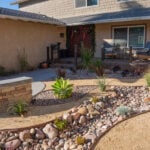Artificial grass has become a popular choice for both residential and commercial landscapes due to its low maintenance and evergreen appearance. Installing a small area of artificial grass is a manageable and rewarding project that can transform an outdoor space into a lush, green oasis. Whether it’s a tiny backyard, a small garden corner, or a balcony, the process requires careful planning and precise execution. Here’s a comprehensive guide on how to install artificial grass in a small area.
Planning and Preparation
- Measure the Area:
Accurate measurements are crucial for purchasing the right amount of artificial grass. Measure both the width and length of the area, and don’t forget to account for any odd shapes or obstructions.
- Gather Materials:
- Artificial grass
- Weed barrier fabric
- Crushed rock or decomposed granite
- Edging materials (bender board, nails, or flexible metal edging)
- Utility knife
- Sand or silica infill (optional)
- Prepare the Site:
- Clear the area of any debris, rocks, or existing grass.
- If the ground is not level, consider adding a layer of gravel or sand and compacting it for a smooth surface.
Installation Steps
- Lay the Base:
- Lay down a weed barrier fabric to prevent weed growth. Cut it to fit the area and secure it in place.
- Add Base Material:
- Spread a layer of crushed rock or decomposed granite (about 2-3 inches) over the weed barrier. Ensure it’s evenly distributed and compact it with a plate compactor for a solid base.
- Install Edging:
- Install edging around the perimeter of the area. Bender boards, nails, or flexible metal edging can be used to secure the artificial grass and prevent it from shifting.
- Unroll and Trim the Artificial Grass:
- Roll out the artificial grass over the prepared area. Ensure it’s oriented correctly and matches the measurements of the space. Allow the grass to acclimate to the environment for a few hours to reduce wrinkles.
- Cut and Shape the Grass:
- Use a utility knife to trim the edges and around any obstacles like posts or curves. Take your time and make precise cuts for a neat fit.
- Secure the Grass:
- Secure the artificial grass by nailing it to the edging every few inches along the perimeter. Be cautious not to create wrinkles or folds while fastening.
- Add Infill (Optional):
- Infill helps the artificial grass blades stand upright and provides weight. Spread sand or silica infill (if recommended for your type of artificial grass) evenly over the surface. Use a stiff brush to work the infill into the grass.
- Brush and Fluff:
- Use a power broom or a stiff-bristled broom to brush against the grass’s natural grain. This process helps the blades stand up and gives the grass a more natural appearance.
Aftercare and Maintenance
Once the artificial grass is installed, it’s essential to maintain it properly to ensure longevity and a vibrant appearance.
- Regular Cleaning: Remove leaves, debris, and any pet waste from the surface. A leaf blower or a stiff brush can help with this task.
- Rinsing: Occasionally, rinse the grass with water to remove dust and refresh its appearance.
- Fluffing the Grass: Brush the grass regularly to prevent matting and keep the fibers upright.
Considerations and Tips
- Quality Matters: Invest in good-quality artificial grass to ensure a more realistic look and enhanced durability.
- Professional Help: If unsure, consider hiring professionals for a flawless installation, especially for more intricate spaces or larger areas.
- Follow Manufacturer Guidelines: Different artificial grass types might have specific installation guidelines. Always refer to the manufacturer’s instructions for the best results.
Environmental and Economic Benefits
Installing artificial grass in a small area not only enhances the visual appeal of a space but also contributes positively to environmental sustainability and offers economic benefits. Therefore, the decision to switch to artificial grass aids in water conservation reduces chemical usage, and minimizes the carbon footprint associated with lawn maintenance.
Moreover, the economic advantages, including reduced water bills, lower maintenance costs, and the long-term durability of artificial grass, make it an economically sound choice for homeowners and businesses. Additionally, its use in public areas enhances community spaces, promoting recreation and events without the concern of damaging the grass surface.
As people continue to prioritize environmentally friendly and cost-effective solutions, artificial grass stands as a commendable choice that aligns with these goals while beautifying outdoor spaces. Whether it’s a small backyard or a community park, the installation of artificial grass reaps both immediate and long-term benefits for individuals and the environment.






